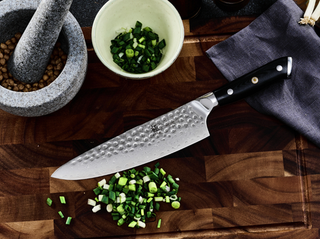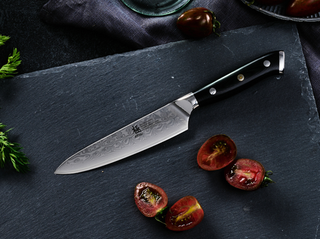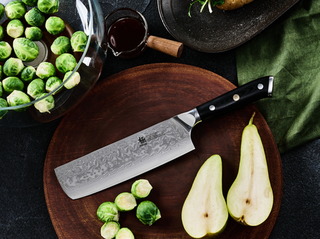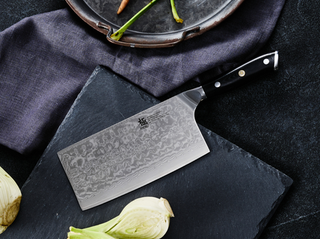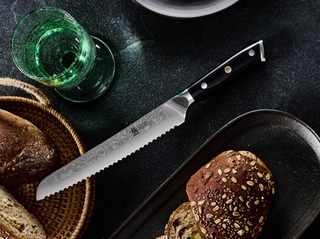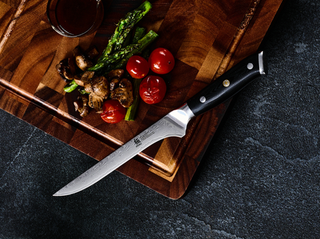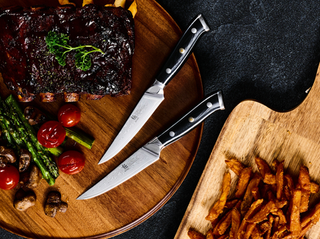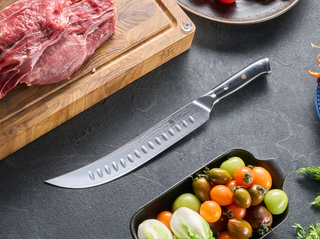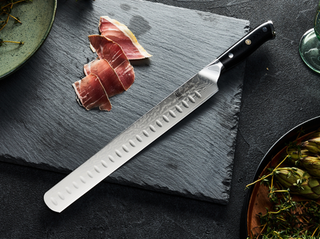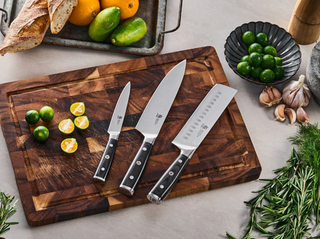Everything you need to know about butcher knife

For cooking enthusiasts and professional chefs, a high-quality butcher knife is an essential tool that ensures accurate and efficient meal preparation. The right butcher knife set will not only make your cooking easier but will also improve your overall cooking experience. With so many options available, choosing the perfect butcher knife set can be a difficult task. This guide explains the important factors to consider so you can make an informed decision and invest in a set that meets your needs.
What is a butcher knife?
A butcher knife is a type of kitchen knife that is specifically designed for use in butchering or preparing meat. It typically has a large, broad blade with a sharp edge and a slightly curved shape, which allows for efficient cutting, slicing, and chopping of meat.
Butcher knives are often heavier and more robust than other kitchen knives to handle the tough tasks involved in butchering, such as splitting bones and separating joints. The blade is usually made of high-carbon stainless steel or carbon steel to ensure durability and sharpness. The handle of a butcher knife is designed to provide a secure and comfortable grip, often made of materials like wood, plastic, or composite materials.
3 ways to select the best butcher knives
1. Select high carbon stainless steel blades.
High-carbon stainless steel blades have excellent edge retention and are stain and corrosion resistant. Look for knives sold as "high carbon" or made of metals such as high carbon steel.
2. Consider the weight and balance of the knife.
The best meat cleaver is one that is neither too light nor too heavy and fits well in your hand. Using a heavy knife with a weight close to the blade will make cutting easier.
3. Test the feel of the knife.
Check the shape and thickness of the blade. Butcher knives come in a variety of shapes to suit specific tasks. Look for a full tang knife for longevity. The thickness of the blade is also important, the thinner the blade, the more skill it requires to use it safely.
The typical thickness is about 0.5 inches near the handle.
The most important factors to evaluate are material quality, comfort, and suitability for your specific cutting needs.
Why do butcher knives have holes
Butcher knives sometimes have holes, commonly known as "dimples" or "Granton edges," on the blade.
These holes serve a specific purpose and provide several benefits:
1. Reduced Friction: The holes on the blade create air pockets between the knife and the food being cut. This helps to reduce friction, allowing the blade to glide more smoothly through the meat. This can make cutting and slicing tasks easier and more efficient.
2. Minimized Sticking: The air pockets created by the holes also help to minimize the suction effect between the blade and the meat. This reduces the likelihood of the meat sticking to the blade while cutting or slicing, making it easier to achieve clean and precise cuts.
3. Improved Presentation: By reducing sticking and tearing of the meat, butcher knives with holes can help maintain the visual appeal of the meat slices. This is particularly important in professional settings such as restaurants or meat shops, where presentation plays a significant role.
4. Easy Cleaning: The holes on the blade can facilitate easier cleaning, as they provide additional surfaces for food particles and juices to pass through. This can help prevent the accumulation of debris on the blade, making it easier to maintain the knife's cleanliness and hygiene.
It's important to note that not all butcher knives have holes, and their presence or absence may vary depending on the specific design and intended use of the knife.
Types of Butcher Knives
Cleaver Knife: A cleaver is a heavy, square-shaped knife with a thick, strong blade that is usually made of high-carbon stainless steel to last and make it easy to clean. Its main purpose is to cut up big pieces of meat, like bones and legs. The cleaver's wide blade and heavy weight make it easy to chop and cut with force. When it's being used a lot, the handle is often ergonomically made to spread the weight evenly and keep the user from getting tired. Cleavers are important tools for butchering in professional kitchens, and they are also used for cultural reasons in Chinese cooking, where they are used for everything from cutting meat into small pieces to slicing veggies. As part of regular care, the edge should be honing and occasionally sharpened to keep it working at its best.
Boning Knife: A breaking knife has a thin, bendy blade made of high-quality steel that stays sharp longer. It is also called a boning knife or butcher's knife. It does a great job of cutting fat, separating meat from bones, and getting rid of shiny skin. The blade is flexible, which makes it easier to move around bones and joints. The handle is made so that you can hold on to it securely and control it precisely. This knife can do many things; it can be used to cut meat or fish fillets. That's why it's important to clean and sharpen the blade often and store it in the right way to keep it in good shape.
Skinning Knife:There is a thin, bent blade on a skinning knife that makes it easy to remove the skin from meat with little waste. The curved shape of the blade makes it easier to move and makes clean cuts along the meat's curves. This knife stays sharp for a long time because it is usually made of flexible high-carbon steel. The handle is made to be comfortable and easy to use while skinning. Both old-fashioned and modern butchers can't do their jobs without skinning knives. To keep working well, they need to be cleaned carefully after each use and sharpened every so often.
Fillet Knife: The fillet knife is mostly used for preparing fish, but it can also be used for more detailed butchering jobs. The thin, flexible blade made of stainless steel gives you great control when you're boning, filleting, and taking skin from smaller pieces of meat. Its handle is shaped in a way that makes it easier to use and more precise for delicate jobs. The fillet knife can be used for both chicken and red meat, and its accuracy is useful in both cases. For regular upkeep, wash it by hand and use a grinding rod to keep the edge sharp.
